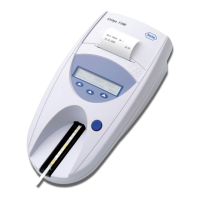Urisys - Operator’s Manual V.
. Quality control (QC)
Quality control (QC) measurements ensure the proper functioning of the analyzer. A QC material for which the results are
known is measured and the results are then compared against the defined ranges for these known results.
Use commercially available urine controls, or other suitable control material. Run a positive and negative control at least
after the weekly calibration (see Section Calibration) and when a new vial of test strips is opened.
Procedure
The test strip handling, measurement procedure, result reporting and data transmission in general are described in
Section . For the QC measurements follow the instruction provided in Section . Normal mode (for Single Reading).
Values obtained for these controls should fall within the limits established by the laboratory or the manufacturer. If the
measured results obtained are outside the established limits follow the troubleshooting actions provided in chapter 9 Error
Messages and Troubleshooting: CONTROL VALUES FALL OUTSIDE THE DESIGNATED RANGES.
. Reading Test Strips
. Overview
The Urisys system is very easy to use. Simply insert the test strip when the sample number is displayed (refer to
Section .), then press the START button to commence reading. The analyzer can be operated in two different modes:
. In Normal Mode, the Urisys system automatically waits for the strip to incubate for seconds before it reads the
first test pad. Seventy seconds after the START button is pressed, the measurement is completed and the test strip tray
moves to the start position. Throughput in this mode is approximately strips per hour.
. In Fast Mode, which can be selected from the menu, the test strip is measured directly after START is pressed. In this
case, it is up to the user to time the incubation period outside the analyzer (see Section .). Using Fast Mode enables
a -second cycle to be maintained.
Each time a strip is read, the grey reference pad in the test strip tray is evaluated to compensate for temperature and aging
effects that may influence the optical system. If the compensation needed is excessive, for example because the reference
pad is badly soiled or an LED is defective and cannot emit the required amount of light, an error message is displayed (see
Sections . and ).
The Urisys system assigns to each reading a consecutive sequence number (sample number) having a maximum of
three digits. The sequence start number automatically reverts to each time the date is incremented. You may, if you wish,
reset the sequence number to via the “New Series” function, for example when one series of measurements has been
completed and another is due to begin.
In Automatic Patient ID mode the instrument will assign automatically unique serial numbers to the tests results which
have no Patient IDs. These unique numbers are ascending serial numbers based on the total number of tests performed on
the instrument and cannot be altered nor cleared.
Whenever there has been five minutes of inactivity, the analyzer automatically switches to Standby mode. The test strip
tray advances slightly so as to close the retaining bar, and the display shows the date and time. The analyzer resumes
Ready-to-Measure status when the START button is pressed.

